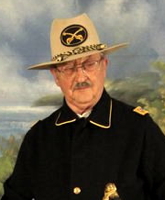Jim Savage
By Richard Duree (Col. Richard Dodge, SASS 1750 Life)
CLICK AN IMAGE TO ENLARGE
In the rich history of our country in general and our state in particular, many noteworthy individuals seem to have passed unnoticed or been forgotten with the passage of time. Yet, their stories are fascinating studies of human courage, dedication, and accomplishment. Such is the story of Jim Savage.
Seemingly appearing from nowhere, Savage had actually crossed in a wagon train from Illinois apparently just prior to the gold discovery, losing his wife and child on the way. He was a "Bear Flagger" and adventurer and was one of the most remarkable men in California's history.
Being a rather enterprising gentleman, he established a series of trading posts near present-day Fresno and prospered from his trade with the Miwok and Mono Indian tribes in the area. The Indian population was very dense here and they were very familiar with the gold deposits in the area. Savage happily exchanged their gold for the goods he carried in his trading posts.
Tall, blonde and blue-eyed, Savage wore red shirts to better impress the Indians and by "going native" he became a member and chief of the Mariposa tribes. It was reported that he took wives from most of them; estimates have run as high as thirty-three.
As elsewhere, the Gold Rush brought ruin to much of the bucolic countryside. Where oak trees once provided plentiful crops of acorns and the canyons teemed with game, gold-crazed Argonauts destroyed the trees and scattered the deer in their mindless quest. Eventually their depredations exhausted the patience and gentle manner of the Mariposa tribes; while Savage was on a business trip to San Francisco, they raided his trading post and killed three employees – remarkable in view of his standing with the tribes – and generally made life tentative for the miners in the area.
Predictably, as was done throughout California in the 1850s, the citizens formed a local militia, the noted Mariposa Battalion. Because of his intimate knowledge of the Indians and his skill as a trapper and scout, Savage was appointed Major in command of the unit and charged with subduing the Indians' revolt. Though most of the tribes soon negotiated peace treaties, two did not: the Yosemites and the Chowchillas.
The Mariposa Battalion dutifully pursued the belligerents and in the course of the chase stumbled upon the magnificent Yosemite Valley, which heretofore was unknown to the Anglos. From Inspiration Point they were the first white men to gaze on one of the most beautiful sights on Earth.
Eventually, even the holdouts were subjugated and peace returned. Savage returned once more to his trading business and again began to prosper. He prospered so much that the local Anglos began to resent his presence and his influence with the Indians. He was warned by a Captain Walter Harvey not to cross over into the Kern River area, adding a slur on Savage's personal qualities. Taking offense, Savage promptly did cross into Harvey's area, confronted the Captain, stating, "I understand, Captain, that you say I am no gentleman." Harvey's response confirmed the insult and Savage flattened the man with a powerful blow. The good Captain, lying flat on his back upped the ante by pulling his revolver and firing four shots into Savage's body, killing him instantly.
And so ended one of California history's more interesting chapters. Few remember Jim Savage's contribution, but the Clampers do. That never-do-well bunch of fun-loving rowdies have a chapter in Fresno: the Jim Savage Chapter of E Clampus Vitus, guaranteeing that the tall, blonde, blue-eyed, red-shirted Indian chief will not be forgotten.
Beck, Warren A.; Ynez D. Hasse; California and the Indian Wars: Mariposa Indian War, 1850-1851
Smith, David A; California and the Indian Wars: The Mariposa War; The Burdick Military History Project, San Jose State University
